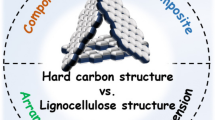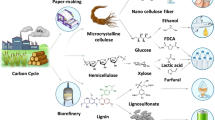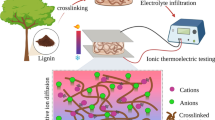Abstract
Under the global issues of environmental pollution and energy crisis, cellulose nanofiber (CNF)–based aerogels have attracted great attention for energy-efficient building application. For safety concern, metal–organic frameworks (MOFs) could be incorporated to endow aerogels with fire retardancy. However, the aerogels prepared by blending of MOFs with cellulose fibers could not achieve fire resistance, while the in situ growth of MOFs in the system with additional chemicals and even environmental unfriendly processes cause high thermal conductivity of the aerogels. In this work, MIL-53(Al) nanoparticles were incorporated to lignocellulosic nanofibril (LCNF) aerogel by carboxymethylated nanocellulose (CMNC) bridging. Such novel binding technique relied on the nanoscaled size and abundant hydroxyl/carboxyl groups of CMNC fibers. In this case, strong molecular interactions were formed between MIL-53(Al) nanoparticles and cellulose fibers to endow aerogel with fire retardancy by char layer formation and gas suppression. In particular, the incorporated MIL-53(Al) nanoparticles provided abundant micropores and somehow prevented the formation of intramolecular hydrogen bonding among fibers to increase the complexity of pore structures. This endowed the aerogel with a thermal conductivity of 30.6 mW m–1 K–1, which also displayed excellent thermal insulation ability at 250 °C and − 196 °C. The green fabrication method would provide a novel idea for the design of MOF/cellulose composites to broaden their applications.
Graphical Abstract







Similar content being viewed by others
Data availability
The data are available from the corresponding author upon reasonable request.
References
Missio AL, Otoni CG, Zhao B, Beaumont M, Khakalo A, Kamarainen T, Silva SHF, Mattos BD, Rojas OJ (2022) Nanocellulose removes the need for chemical crosslinking in tannin-based rigid foams and enhances their strength and fire retardancy. ACS Sustain Chem Eng 10(31):10303–10310. https://doi.org/10.1021/acssuschemeng.2c02678
Lu L-X, Wang X-L, Li S-L, Tang Y, Mai X-M (2022) Thermal performance of lonicera rupicola grass as a building insulation composite material. Adv Compos Hybrid Mater 6(1):8. https://doi.org/10.1007/s42114-022-00578-0
Ge S, Ouyang H, Ye H, Shi Y, Sheng Y, Peng W (2023) High-performance and environmentally friendly acrylonitrile butadiene styrene/wood composite for versatile applications in furniture and construction. Adv Compos Hybrid Mater 6(1):44 https://doi.org/10.1007/s42114-023-00628-1
Xie W, Yao F, Gu H, Du A, Lei Q, Naik N, Guo Z (2022) Magnetoresistive and piezoresistive polyaniline nanoarrays in-situ polymerized surrounding magnetic graphene aerogel. Adv Compos Hybrid Mater 5(2):1003–1016. https://doi.org/10.1007/s42114-021-00413-y
Xu T, Du H, Liu H, Liu W, Zhang X, Si C, Liu P, Zhang K (2021) Advanced nanocellulose-based composites for flexible functional energy storage devices. Adv Mater 33(48):e2101368. https://doi.org/10.1002/adma.202101368
Chen Y, Zhang L, Yang Y, Pang B, Xu W, Duan G, Jiang S, Zhang K (2021) Recent progress on nanocellulose aerogels: preparation, modification, composite fabrication, applications. Adv Mater 33(11):e2005569. https://doi.org/10.1002/adma.202005569
Gu H, Huo X, Chen J, M. El-Bahy S, M. El-Bahy Z, (2022) An overview of cellulose aerogel: classification and applications. ES Food & Agrofor 10:1–9. https://doi.org/10.30919/esfaf782
Khan S, Ul-Islam M, Fatima A, Manan S, Khattak WA, Wajid Ullah MW, Yang G (2023) Potential of food and agro-industrial wastes for cost-effective bacterial cellulose production: an updated review of literature. ES Food & Agrofor 13:905. https://doi.org/10.30919/esfaf905
Ye M, Wang S, Ji X, Tian Z, Dai L, Si C (2022) Nanofibrillated cellulose-based superhydrophobic coating with antimicrobial performance. Adv Compos Hybrid Mater 6(1):30. https://doi.org/10.1007/s42114-022-00602-3
Zhang H-C, Yu C-N, Li X-Z, Wang L-F, Huang J, Tong J, Lin Y, Min Y, Liang Y (2022) Recent developments of nanocellulose and its applications in polymeric composites. ES Food & Agrofor 9:1–14. https://doi.org/10.30919/esfaf768
Zhou S, Apostolopoulou-Kalkavoura V, Tavares da Costa MV, Bergstrom L, Stromme M, Xu C (2019) Elastic aerogels of cellulose nanofibers@metal-organic frameworks for thermal insulation and fire retardancy. Nano-Micro Lett 12(1):9. https://doi.org/10.1007/s40820-019-0343-4
Li W, Li Z, Wang W, Li Z, Li Q, Qin C, Cao F (2021) Green approach to facilely design hydrophobic aerogel directly from bagasse. Ind Crop Prod 172:113957. https://doi.org/10.1016/j.indcrop.2021.113957
Pan D, Dong J, Yang G, Su F, Chang B, Liu C, Zhu Y-C, Guo Z (2021) Ice template method assists in obtaining carbonized cellulose/boron nitride aerogel with 3D spatial network structure to enhance the thermal conductivity and flame retardancy of epoxy-based composites. Adv Compos Hybrid Mater 5(1):58–70. https://doi.org/10.1007/s42114-021-00362-6
Ren X, Song M, Jiang J, Yu Z, Zhang Y, Zhu Y, Liu X, Li C, Oguzlu-Baldelli H, Jiang F (2022) Fire-retardant and thermal-insulating cellulose nanofibril aerogel modified by in situ supramolecular assembly of melamine and phytic acid. Adv Eng Mater 24(8):2101534. https://doi.org/10.1002/adem.202101534
Huang J, Wang X, Guo W, Niu H, Song L, Hu Y (2022) Eco-friendly thermally insulating cellulose aerogels with exceptional flame retardancy, mechanical property and thermal stability. J Taiwan Inst Chem E 131:104159. https://doi.org/10.1016/j.jtice.2021.104159
Rahaman SJ, Samanta A, Mir MH, Dutta B (2022) Metal-organic frameworks (MOFs): a promising candidate for stimuli-responsive drug delivery. ES Mater Manuf 19:792–2. https://doi.org/10.30919/esmm5f792
Wang C, Liu X, Yang T, Sridhar D, Algadi H, Bin XuB, El-Bahy ZM, Li H, Ma Y, Li T, Guo Z (2023) An overview of metal-organic frameworks and their magnetic composites for the removal of pollutants. Sep Purif Technol 320:124144. https://doi.org/10.1016/j.seppur.2023.124144
Xu H, Zu M, Cheng H, Liu D, Xie W (2022) A composite coating based on metal–organic framework MIL-101(Cr) synthesised by L-malic acid as mineralising agent for thermal management. Adv Compos Hybrid Mater 5(4):2896–2905. https://doi.org/10.1007/s42114-022-00481-8
Zhang S, Cheng B, Jia Z, Zhao Z, Jin X, Zhao Z, Wu G (2022) The art of framework construction: hollow-structured materials toward high-efficiency electromagnetic wave absorption. Adv Compos Hybrid Mater 5(3):1658–1698. https://doi.org/10.1007/s42114-022-00514-2
Xue R, Guo H, Yang W, Huang S-L, Yang G-Y (2022) Cooperation between covalent organic frameworks (COFs) and metal organic frameworks (MOFs): application of COFs-MOFs hybrids. Adv Comp Hybrid Mater 5(3):1595–1611. https://doi.org/10.1007/s42114-022-00432-3
Lu Y, Liu C, Mei C, Sun J, Lee J, Wu Q, Hubbe MA, Li M-C (2022) Recent advances in metal organic framework and cellulose nanomaterial composites. Coordin Chem Rev 461:214496. https://doi.org/10.1016/j.ccr.2022.214496
Nabipour H, Nie S, Wang X, Song L, Hu Y (2019) Highly flame retardant zeolitic imidazole framework-8@cellulose composite aerogels as absorption materials for organic pollutants. Cellulose 27(4):2237–2251. https://doi.org/10.1007/s10570-019-02860-9
Zhou J, Fang M, Yang K, Lu K, Fei H, Mu P, He R (2022) MIL-101(Cr)-NH2/reduced graphene oxide composite carrier enhanced thermal conductivity and stability of shape-stabilized phase change materials for thermal energy management. J Energy Storage 52:104827. https://doi.org/10.1016/j.est.2022.104827
Zhu SQ, Shu JC, Cao MS (2022) Novel MOF-derived 3D hierarchical needlelike array architecture with excellent EMI shielding, thermal insulation and supercapacitor performance. Nanoscale 14(19):7322–7331. https://doi.org/10.1039/d2nr01024k
Kr M, Ahmed S, AZ M, EKH A., KE M (2021) A novel sensitive and selective chemosensor for fluorescent detection of Zn2+ in cosmetics creams based on a covalent post functionalized Al-MOF. New J Chem 45(18):8054 https://doi.org/10.1039/c4gc01861c
Wang Y, He L, Li Y, Jing L, Wang J, Li X (2020) Ag NPs supported on the magnetic Al-MOF/PDA as nanocatalyst for the removal of organic pollutants in water. J Alloy Compd 828(C):154340. https://doi.org/10.1016/j.jallcom.2020.154340
Berardi U, Iannace G (2015) Acoustic characterization of natural fibers for sound absorption applications. Build Environ 94:840–852. https://doi.org/10.1016/j.buildenv.2015.05.029
Sijie W, Xiang L, Ying C, Nana L, Yi D, Shixue D, Lei J, Qunfeng C (2021) High-strength scalable MXene films through bridging-induced densification. Science 374(6563):96. https://doi.org/10.1126/science.abg2026
Sakuma W, Yamasaki S, Fujisawa S, Kodama T, Shiomi J, Kanamori K, Saito T (2021) Mechanically strong, scalable, mesoporous xerogels of nanocellulose featuring light permeability, thermal insulation, and flame self-extinction. ACS Nano 15(1):1436–1444. https://doi.org/10.1021/acsnano.0c08769
Ran F, Li C, Hao Z, Zhang X, Dai L, Si C, Shen Z, Qiu Z, Wang J (2022) Combined bactericidal process of lignin and silver in a hybrid nanoparticle on E. coli. Adv Compos Hybrid Mater 5(3):1841–1851. https://doi.org/10.1007/s42114-022-00460-z
Mu L, Dong Y, Li L, Gu X, Shi Y (2021) Achieving high value utilization of bio-oil from lignin targeting for advanced lubrication. ES Mater Manuf 11:72–80. https://doi.org/10.30919/esmm5f1146
Culebras M, Collins GA, Beaucamp A, Geaney H, Collins MN (2022) Lignin/Si hybrid carbon nanofibers towards highly efficient sustainable Li-ion anode materials. Eng Sci 17:195–203. https://doi.org/10.30919/es8d608
Zhang S, Li W, Wang W, Qin C, Wang S (2022) Paper-based dual-mode liquid manipulation system: oil/water separation and time-lapse droplet switch. Chem Eng J 427:131606. https://doi.org/10.1016/j.cej.2021.131606
Qin C, Wang W, Li W, Zhang S, Li Z (2021) Developing bagasse towards superhydrophobic coatings. Cellulose 28(6):3617–3630. https://doi.org/10.1007/s10570-021-03743-8
Li Z, Zhang Y, Huang Q, Chen Z, Wang W, Li W (2023) Tailorable lignocellulose-based aerogel to achieve the balance between evaporation enthalpy and water transport rate for efficient solar evaporation. ACS Appl Mater Interfaces 15(9):11827–11836. https://doi.org/10.1021/acsami.2c22615
Li Y, Li X, Wang B (2022) Controlling metal clusters in breathing metal-organic framework nanostructures for boosting visible-light-induced ·OH radical formation. ACS Appl Nano Mater 5(2):2510–2521. https://doi.org/10.1021/acsanm.1c04183
Zhu L, Zong L, Wu X, Li M, Wang H, You J, Li C (2018) Shapeable fibrous aerogels of metal-organic-frameworks templated with nanocellulose for rapid and large-capacity adsorption. ACS Nano 12(5):4462–4468. https://doi.org/10.1021/acsnano.8b00566
Lu W, Duan C, Liu C, Zhang Y, Meng X, Dai L, Wang W, Yu H, Ni Y (2020) A self-cleaning and photocatalytic cellulose-fiber- supported "Ag@AgCl@MOF- cloth’’ membrane for complex wastewater remediation. Carbohydr Polym 247:116691. https://doi.org/10.1016/j.carbpol.2020.116691
Yu X, Tong S, Ge M, Zuo J, Cao C, Song W (2013) One-step synthesis of magnetic composites of cellulose@iron oxide nanoparticles for arsenic removal. J Mater Chem A 1:959. https://doi.org/10.1039/c2ta00315e
Rahmani E, Rahmani M (2017) Al-based MIL-53 metal organic framework (MOF) as the new catalyst for Friedel-Crafts alkylation of benzene. Ind Eng Chem Res 57(1):169–178. https://doi.org/10.1021/acs.iecr.7b04206
Mounfield WP 3rd, Walton KS (2015) Effect of synthesis solvent on the breathing behavior of MIL-53(Al). J Colloid Interf Sci 447:33–39. https://doi.org/10.1016/j.jcis.2015.01.027
Yang H, Yang L, Wang H, Xu Z, Zhao Y, Luo Y, Nasir N, Song Y, Wu H, Pan F, Jiang Z (2019) Covalent organic framework membranes through a mixed-dimensional assembly for molecular separations. Nat Commun 10(1):2101. https://doi.org/10.1038/s41467-019-10157-5
Naduparambath S, T VJ, V S, M PS, Balan AK, E P, (2018) Isolation and characterisation of cellulose nanocrystals from sago seed shells. Carbohydr Polym 180:13–20. https://doi.org/10.1016/j.carbpol.2017.09.088
Han X, Ding S, Fan L, Zhou Y, Wang S (2021) Janus biocomposite aerogels constituted of cellulose nanofibrils and MXenes for application as single-module solar-driven interfacial evaporators. J Mater Chem A 9(34):18614–18622. https://doi.org/10.1039/d1ta04991g
Sun X, Xu W, Zhang X, Lei T, Lee S-Y, Wu Q (2021) ZIF-67@Cellulose nanofiber hybrid membrane with controlled porosity for use as Li-ion battery separator. J Energy Chem 52:170–180. https://doi.org/10.1016/j.jechem.2020.04.057
Qin H, Zhang Y, Jiang J, Wang L, Song M, Bi R, Zhu P, Jiang F (2021) Multifunctional superelastic cellulose nanofibrils aerogel by dual ice-templating assembly. Adv Funct Mater 31(46):2106269. https://doi.org/10.1002/adfm.202106269
Fan Q, Ou R, Hao X, Deng Q, Liu Z, Sun L, Zhang C, Guo C, Bai X, Wang Q (2022) Water-induced self-assembly and in situ mineralization within plant phenolic glycol-gel toward ultrastrong and multifunctional thermal insulating aerogels. ACS Nano 16(6):9062–9076. https://doi.org/10.1021/acsnano.2c00755
Sun L, Liao B, Sheberla D, Kraemer D, Zhou J, Stach EA, Zakharov D, Stavila V, Talin AA, Ge Y, Allendorf MD, Chen G, Léonard F, Dincă M (2017) A microporous and naturally nanostructured thermoelectric metal-organic framework with ultralow thermal conductivity. Joule 1(1):168–177. https://doi.org/10.1016/j.joule.2017.07.018
Zhang X, Zhao X, Xue T, Yang F, Fan W, Liu T (2020) Bidirectional anisotropic polyimide/bacterial cellulose aerogels by freeze-drying for super-thermal insulation. Chem Eng J 385:123963. https://doi.org/10.1016/j.cej.2019.123963
Wang S, Meng W, Lv H, Wang Z, Pu J (2021) Thermal insulating, light-weight and conductive cellulose/aramid nanofibers composite aerogel for pressure sensing. Carbohydr Polym 270:118414. https://doi.org/10.1016/j.carbpol.2021.118414
Cao M, Li SL, Cheng JB, Zhang AN, Wang YZ, Zhao HB (2021) Fully bio-based, low fire-hazard and superelastic aerogel without hazardous cross-linkers for excellent thermal insulation and oil clean-up absorption. J Hazard Mater 403:123977. https://doi.org/10.1016/j.jhazmat.2020.123977
Wu K, Wu H, Wang R, Yan X, Sun W, Liu Y, Kuang Y, Jiang F, Chen S (2022) The use of cellulose fiber from office waste paper to improve the thermal insulation-related property of konjac glucomannan/starch aerogel. Ind Crop Prod 177:114424. https://doi.org/10.1016/j.indcrop.2021.114424
Li SL, Wang J, Zhao HB, Cheng JB, Zhang AN, Wang T, Cao M, Fu T, Wang YZ (2021) Ultralight biomass aerogels with multifunctionality and superelasticity under extreme conditions. ACS Appl Mater Interfaces 13(49):59231–59242. https://doi.org/10.1021/acsami.1c17216
Berglund L, Nissila T, Sivaraman D, Komulainen S, Telkki VV, Oksman K (2021) Seaweed-derived alginate-cellulose nanofiber aerogel for insulation applications. ACS Appl Mater Interfaces 13(29):34899–34909. https://doi.org/10.1021/acsami.1c07954
Qi XL, Zhou DD, Zhang J, Hu S, Haranczyk M, Wang DY (2019) Simultaneous improvement of mechanical and fire-safety properties of polymer composites with phosphonate-loaded MOF additives. ACS Appl Mater Interfaces 11(22):20325–20332. https://doi.org/10.1021/acsami.9b02357
Liu BW, Zhao HB, Wang YZ (2022) Advanced flame-retardant methods for polymeric materials. Adv Mater 34(46):e2107905. https://doi.org/10.1002/adma.202107905
Wang J, Wei Y, Wang Z, He X, Wang C, Lin H, Deng Y (2022) MOFs-derived self-sacrificing template strategy to double-shelled metal oxides nanocages as hierarchical interfacial catalyst for suppressing smoke and toxic gases releases of epoxy resin. Chem Eng J 432:134328. https://doi.org/10.1016/j.cej.2021.134328
Feng J, Ma Z, Xu Z, Xie H, Lu Y, Maluk C, Song P, Bourbigot S, Wang H (2022) A Si-containing polyphosphoramide via green chemistry for fire-retardant polylactide with well-preserved mechanical and transparent properties. Chem Eng J 431:134259. https://doi.org/10.1016/j.cej.2021.134259
Lou G, Ma Z, Dai J, Bai Z, Fu S, Huo S, Qian L, Song P (2021) Fully biobased surface-functionalized microcrystalline cellulose via green self-assembly toward fire-retardant, strong, and tough epoxy biocomposites. ACS Sustain Chem Eng 9(40):13595–13605. https://doi.org/10.1021/acssuschemeng.1c04718
Zou S, Dang L, Li Y, Lan S, Zhu D, Li L (2022) Inorganic-organic dual modification of magnesium borate whisker by magnesium hydrate and dodecyl dihydrogen phosphate and its effect on the fire safety and mechanical properties of epoxy resin. Appl Surf Sci 589:153064. https://doi.org/10.1016/j.apsusc.2022.153064
Zhang L, Zhang W, Peng Y, Wang W, Cao J (2022) Thermal behavior and flame retardancy of poplar wood impregnated with furfuryl alcohol catalyzed by boron/phosphorus compound system. Ind Crop Prod 176:114361. https://doi.org/10.1016/j.indcrop.2021.114361
Zhou Y, Chu F, Yang W, Qiu S, Hu Y (2022) MOF-derived strategy to obtain CuCoOx functionalized HO-BN: a novel design to enhance the toughness, fire safety and heat resistance of bismaleimide resin. Chem Eng J 431:134013. https://doi.org/10.1016/j.cej.2021.134013
Fu Q, Liu Y, Liu T, Mo J, Zhang W, Zhang S, Luo B, Wang J, Qin Y, Wang S, Nie S (2022) Air-permeable cellulosic triboelectric materials for self-powered healthcare products. Nano Energy 102:107739. https://doi.org/10.1016/j.nanoen.2022.107739
Ali M, Gabr HS, Mahmoud AH, Aboubakr D (2021) Assessing and characterizing the perception of soundscape in the Urban Park: a case study of Zayed Park. Egypt. Eng Sci 16:393–402. https://doi.org/10.30919/es8d593
Zhao X, Hu Y, Xu X, Li M, Han Y, Huang S (2023) Sound absorption polyimide composite aerogels for ancient architectures’ protection. Adv Compos Hybrid Mater 6(4):137. https://doi.org/10.1007/s42114-023-00716-2
Yu J, Zhang Y, Guo Q, Hou H, Ma Y, Zhao Y (2022) Effect of pressure on anisotropy in elasticity, sound velocity, and thermal conductivity of vanadium borides. Adv Compos Hybrid Mater 5(3):2297–2305. https://doi.org/10.1007/s42114-021-00403-0
Zhao X, Ruan K, Qiu H, Zhong X, Gu J (2023) Fatigue-resistant polyimide aerogels with hierarchical cellular structure for broadband frequency sound absorption and thermal insulation. Adv Compos Hybrid Mater 6(5):171. https://doi.org/10.1007/s42114-023-00747-9
He C, Huang J, Li S, Meng K, Zhang L, Chen Z, Lai Y (2017) Mechanically resistant and sustainable cellulose-based composite aerogels with excellent flame retardant, sound-absorption, and superantiwetting ability for advanced engineering materials. ACS Sustain Chem Eng 6(1):927–936. https://doi.org/10.1021/acssuschemeng.7b03281
Funding
This work was supported by the Natural Science Foundation of Guangxi (2018GXNSFBA138027), Scientific Research Foundation of Guangxi University (XGZ170232) and Innovation Project of Guangxi Graduate Education (YCSW2022044).
Author information
Authors and Affiliations
Contributions
Zerong Li: Methodology, Analysis, and Writing—original draft preparation. Zhuoling Chen: Investigation. Qiaoling Huang: Investigation. Song Zhang: Writing–review & editing. Wei Wang: Resources and Software. Wei Li: Conceptualization, Funding acquisition, Supervision, Writing–review and editing, and Project administration. All authors have given approval to the final version of the manuscript.
Corresponding author
Ethics declarations
Competing interests
The authors declare no competing interests.
Additional information
Publisher's Note
Springer Nature remains neutral with regard to jurisdictional claims in published maps and institutional affiliations.
Supplementary Information
Below is the link to the electronic supplementary material.
Rights and permissions
Springer Nature or its licensor (e.g. a society or other partner) holds exclusive rights to this article under a publishing agreement with the author(s) or other rightsholder(s); author self-archiving of the accepted manuscript version of this article is solely governed by the terms of such publishing agreement and applicable law.
About this article
Cite this article
Li, Z., Chen, Z., Huang, Q. et al. MOF@lignocellulosic nanofibril aerogel designed by carboxymethylated nanocellulose bridging for thermal insulation and fire retardancy. Adv Compos Hybrid Mater 7, 28 (2024). https://doi.org/10.1007/s42114-024-00844-3
Received:
Revised:
Accepted:
Published:
DOI: https://doi.org/10.1007/s42114-024-00844-3




